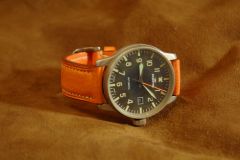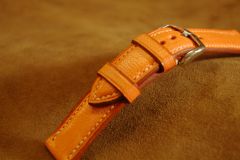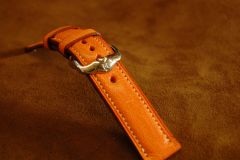
cjmt
Members-
Posts
174 -
Joined
-
Last visited
Content Type
Profiles
Forums
Events
Blogs
Gallery
Everything posted by cjmt
-
For use with a filiteuse and soft leather you want something like the edge finish from Beraud - its very effective but rather difficult and very time consuming in use. In England we still commonly use both glass for edges and a lot of the trade mixes their own edge finishes with powder dye and pearl glue still. I personally glass for multi layers of thick leather and its very effective. Charlie
-
Another Watch Strap
cjmt replied to edd's topic in Purses, Wallets, Belts and Miscellaneous Pocket Items
Nice stuff - like them. Hand stitched? Charlie -
Watch Strap Prototype
cjmt replied to cjmt's topic in Purses, Wallets, Belts and Miscellaneous Pocket Items
Thank you - I work hard on making each one of something better than the last one I made and my own philosophy is that perfection is an unatainable goal, you always can and should do better. I am not a patient person so I struggle with not rushing! Charlie -
Watch Strap Prototype
cjmt replied to cjmt's topic in Purses, Wallets, Belts and Miscellaneous Pocket Items
Another quick photo, similar to the last I guess Oak bark tanned bridle leather, light brown Lin Cable, the edge finishing technique thats been discussed recently with the finish from Beraud Charlie -
Watch Strap Prototype
cjmt replied to cjmt's topic in Purses, Wallets, Belts and Miscellaneous Pocket Items
Hi Todd All hand cut. I think even if you used a clicker for the strap you'd have to punch the holes when the strap is assembled anyway. The chape is punched pre stitching of course but the holes for adjustment are the last thing I do HTH Charlie -
Dont know, but it looks like what I use at least Charlie
-
Watch Strap Prototype
cjmt replied to cjmt's topic in Purses, Wallets, Belts and Miscellaneous Pocket Items
I dont skive the top keeper, I leave a gap in the middle layer of padding for the keeper to sit in so the thickness is more or less the same, other than that spot on. The knack with little fiddly things is to go slowly - dont rush complicated things and they arent that complicated on the whole. The art is in doing things in the right order and then not spoiling what youve already done by going at it hammer and tongs, imho at least Charlie -
Watch Strap Prototype
cjmt replied to cjmt's topic in Purses, Wallets, Belts and Miscellaneous Pocket Items
Cheaper source for the Stinke book which is seen as the standard text for trainee Master Saddlery courses over here http://www.ebay.co.uk/itm/BRIDLEWORK-by-Robert-H-Steinke-signed-by-author/220698954436?ssPageName=WDVW&rd=1&ih=012&category=16245&cmd=ViewItem -
Watch Strap Prototype
cjmt replied to cjmt's topic in Purses, Wallets, Belts and Miscellaneous Pocket Items
Certainly! The fixed keeper is just stitched in to the strap on both sides. Remember they are hand stitched so you can do that much more easily than with a sewing machine. The second keeper is a running keeper, its stitched but to itself and completely free. Does that make sense? Regarding books, Ive never really referred to them so no great personal recommendations. I know some people have used these though http://www.amazon.co.uk/The-Leatherworking-Handbook-Valerie-Michael/dp/0304345113 http://www.amazon.co.uk/Bridlework-Robert-H-Steinke/dp/0851316409/ref=sr_1_fkmr0_1?ie=UTF8&qid=1381434868&sr=8-1-fkmr0&keywords=stinke+bridlework Once you are able to handstitch competently and are able to use the basic tools in all honesty you can work out how most things are made and the thing you need to do is look at pictures and give things a go Hope that helps, Charlie -
Making Camera Bag
cjmt replied to hunio's topic in Purses, Wallets, Belts and Miscellaneous Pocket Items
Can I ask what leather your using? It looks rather like gold Barenia? The whole thing looks like its going to be a lovely bag Charlie -
Watch Strap Prototype
cjmt replied to cjmt's topic in Purses, Wallets, Belts and Miscellaneous Pocket Items
Thanks, much appreciated! Thank you also for the kind words! The straps are hand stitched so starting and finishing is easy, you just start or fininsh 1 1/2 stitches from the end so you have a small amount of overlap. The thread is pretty thin and if you're careful the double stitching is more or less invisible. No reason this wouldnt work - interesting thought. In the case of these watch straps I tend to glue right up to the very edge so the edges are both glued and stitched, the object being no gape at all between them when you come to polish and seal the edges - makes it much easier to get a well finished edge. Charlie -
Making Camera Bag
cjmt replied to hunio's topic in Purses, Wallets, Belts and Miscellaneous Pocket Items
Really lovely work -
Watch Strap Prototype
cjmt replied to cjmt's topic in Purses, Wallets, Belts and Miscellaneous Pocket Items
Theres no structural glue, all the elements are held together by the stitching, but the filling strip and other layers are glued in place to make sure they don't move whilst the straps are being stitched, to make sure they are lined up perfectly and to help give a good single edge to then sand/polish. Glue as a permanent bond is poor technique (to me) but glue used as a temporary bond is OK, you just have to not get it in the cut edges because it plays havoc with edge finishing. HTH Charlie -
This - I suspect we are all costing each other quite a lot competing for the good tools! Charlie
-
Watch Strap Prototype
cjmt replied to cjmt's topic in Purses, Wallets, Belts and Miscellaneous Pocket Items
Thank you :-) -
We use the same edge finish, though sourced directly. Its extremely useful for fine or chrome leathers that cant otherwise be burnished and/or getting contrast edges on leathers that wick dye . You can achieve a very high standard of finish thats a country mile ahead of Edge Kote or similar, but its very time consuming and takes a lot of practice to get there. Charlie
-
Watch Strap Prototype
cjmt replied to cjmt's topic in Purses, Wallets, Belts and Miscellaneous Pocket Items
Another one - not a prototype this time. This is 24mm wide oak bark tanned bridle leather with light brown lin cable made for a Panerai collector Charlie -
Watch Strap Prototype
cjmt replied to cjmt's topic in Purses, Wallets, Belts and Miscellaneous Pocket Items
Absolutely just like a mini belt. I make each part of the strap from one piece of leather folded over on the whole though rather than a different lining and face leather like most people do. My experience is that aside from being able to get the leather you want thin enough the only difficulty in a strap is getting the stitching and the edges right. In particular the edges when you start to get the layers of leather outer down to c. 1mm are very, very difficult to burnish/finish. The devil indeed is in the detail, you have to enjoy fiddley work to do them I think Charlie -
Watch Strap Prototype
cjmt replied to cjmt's topic in Purses, Wallets, Belts and Miscellaneous Pocket Items
Surprisingly your sarcasm hasn't made me feel like spending an hour writing down every step of a process I spent a lot of hours developing so you dont have to. Do you have specific questions that you've taken the time to think about and research or did you just want me to spoon feed you? -
Watch Strap Prototype
cjmt replied to cjmt's topic in Purses, Wallets, Belts and Miscellaneous Pocket Items
Yes, basically exactly that, some goat or thinned bridle leather stitched around a spacer. We hand stitch everything, including these. They are basically very simple things - the devil is in the detail though and I find you (or at least I) have to try really hard on something this little and fiddly to get the finish and detail just right, they are very unforgiving and really show up flaws in your work. Charlie -
Watch Strap Prototype
cjmt replied to cjmt's topic in Purses, Wallets, Belts and Miscellaneous Pocket Items
It seems to be fine - its only a week old but wearing well. Its quite light and very comfortable. The leather is fully aniline so will pick up marks Im sure, its all part of the character of good leather though.The central raised area is c.1mm veg tanned cow, the stretch resistance is coming from the stitched goat though, its c. 1mm so enough strength not to stretch Charlie -
Hi All, Theres been some more interest on here in leatherwork in the European style so thought I'd post some recent pictures. This is a 20mm watch strap in Tangerine Goatskin handstitched at 10 spi in 532 Ecru Lin Cable. Its not perfect of course, it was made to see if the goat was strong enough to make a strap from Charlie
-
From the album: Watch Strap
-
From the album: Watch Strap







